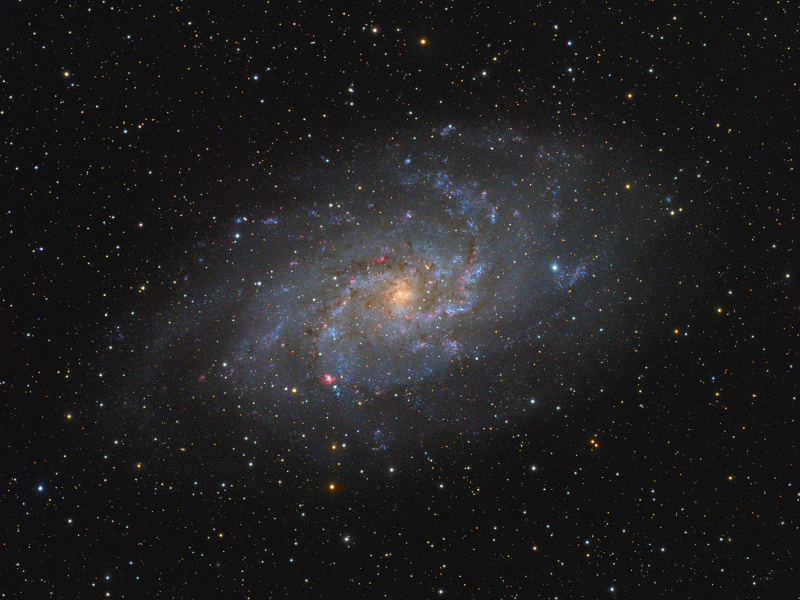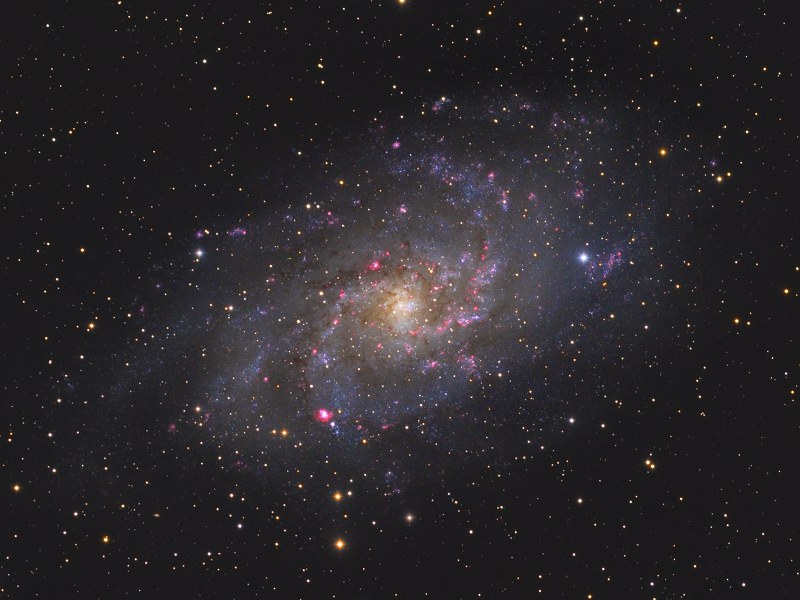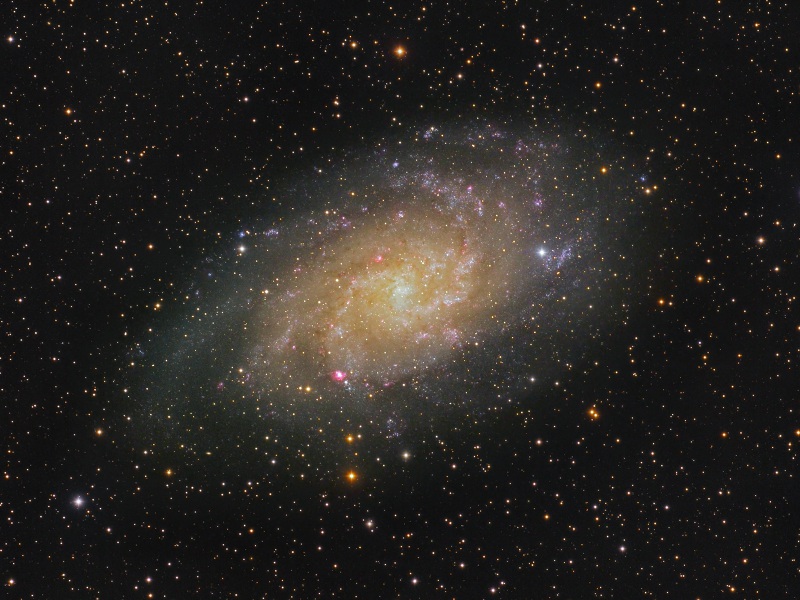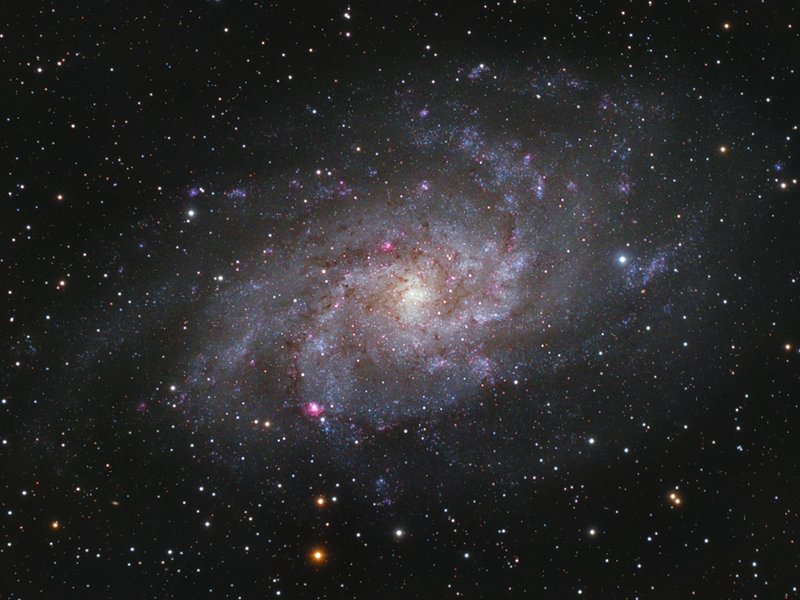Galaxy M33
Photo Details

Telescope: Cff92 f4.6

Camera: Asi2600

Mount: NJP Takahashi

Guiding: Off-axis Lodestar

Exposure: L 10x3min, RGB 5x5min each

When: August 2022

Other information: T
Photo Details

Telescope: FSQ106EDX (530 mm) Takahashi

Camera: Asi1600MMC-p

Mount: NJP Takahashi

Guiding: Off-axis Lodestar

Exposure: LRGB 80,30,30,30 x 1min Unity Gain

When: September 2018

Other information: good transparency and seeing T
Photo Details

Telescope: FSQ106EDX (530 mm) Takahashi

Camera: Sbig ST-8300M, Sbig Filter wheel, Baader 36mm round HLRGB filters

Mount: NJP Takahashi

Guiding: Orion ST80 with Orion SS Autoguider

Exposure: L 21x480sec RGB 8x480sec H 14x1200sec

When: Fall 2012 and 2013

Other information: very good transparency, very good seeing
Photo Details

Telescope: FSQ106EDX (530 mm) Takahashi

Camera: Sbig ST-8300M, Sbig Filter wheel, Baader 36mm round HLRGB filters

Mount: NJP Takahashi

Guiding: Orion ST80 with Orion SS Autoguider

Exposure: L 21x480sec RGB 8x480sec

When: Fall 2012

Other information: very good transparency, very good seeing
Photo Details

Telescope: FSQ106EDX (530 mm) Takahashi

Camera: Sbig ST-2000XM, Sbig Filter wheel, Baader 1.25" HLRGB filters

Mount: NJP Takahashi

Guiding: Self-guided

Exposure: LRGB 6.h L 18x600sec, color 3h ST2000CXM

When: ----

Other information: very good transparency, very good seeing
The Triangulum Galaxy is a spiral galaxy approximately 3 million light years (ly) from Earth in the constellation Triangulum. It is catalogued as Messier 33 or NGC 598, and is sometimes informally referred to as the Pinwheel Galaxy, a nickname it shares with Messier 101. The Triangulum Galaxy is the third-largest member of the Local Group of galaxies, which includes the Milky Way Galaxy, the Andromeda Galaxy and about 30 other smaller galaxies. It is one of the most distant permanent objects that can be viewed with the naked eye.
The Triangulum Galaxy was probably discovered by the Italian astronomer Giovanni Battista Hodierna before 1654. In his work De systemate orbis cometici; deque admirandis coeli caracteribus ("About the systematics of the cometary orbit, and about the admirable objects of the sky"), he listed it as a cloud-like nebulosity or obsuration and gave the cryptic description, "near the Triangle hinc inde". This is in reference to the constellation of Triangulum as a pair of triangles. The magnitude of the object matches M33, so it is most likely a reference to the Triangulum galaxy.
The galaxy was independently discovered by Charles Messier on the night of August 25–26, 1764. It was published in his Catalog of Nebulae and Star Clusters (1771) as object number 33; hence the name M33. When William Herschel compiled his extensive catalogue of nebulae, he was careful not to include most of the objects identified by Messier. However, M33 was an exception and he catalogued this object on September 11, 1784 as H V-17.
NGC 604 in the Triangulum Galaxy
Herschel also catalogued the Triangulum Galaxy's brightest and largest H II region (diffuse emission nebula containing ionized hydrogen) as H III.150 separately from the galaxy itself, which eventually obtained NGC number 604. As seen from Earth, NGC 604 is located northeast of the galaxy's central core. It is one of the largest H II regions known, with a diameter of nearly 1500 light-years and a spectrum similar to that of the Orion Nebula. Herschel also noted 3 other smaller H II regions (NGC 588, 592 and 595).



 Telescope: Cff92 f4.6
Telescope: Cff92 f4.6 Camera: Asi2600
Camera: Asi2600  Mount: NJP Takahashi
Mount: NJP Takahashi Guiding: Off-axis Lodestar
Guiding: Off-axis Lodestar Exposure: L 10x3min, RGB 5x5min each
Exposure: L 10x3min, RGB 5x5min each  When: August 2022
When: August 2022 Other information: T
Other information: T
 Telescope: FSQ106EDX (530 mm) Takahashi
Telescope: FSQ106EDX (530 mm) Takahashi Camera: Asi1600MMC-p
Camera: Asi1600MMC-p  Mount: NJP Takahashi
Mount: NJP Takahashi Guiding: Off-axis Lodestar
Guiding: Off-axis Lodestar Exposure: LRGB 80,30,30,30 x 1min Unity Gain
Exposure: LRGB 80,30,30,30 x 1min Unity Gain  When: September 2018
When: September 2018 Other information: good transparency and seeing T
Other information: good transparency and seeing T
 Telescope: FSQ106EDX (530 mm) Takahashi
Telescope: FSQ106EDX (530 mm) Takahashi Camera: Sbig ST-8300M, Sbig Filter wheel, Baader 36mm round HLRGB filters
Camera: Sbig ST-8300M, Sbig Filter wheel, Baader 36mm round HLRGB filters Mount: NJP Takahashi
Mount: NJP Takahashi Guiding: Orion ST80 with Orion SS Autoguider
Guiding: Orion ST80 with Orion SS Autoguider Exposure: L 21x480sec RGB 8x480sec H 14x1200sec
Exposure: L 21x480sec RGB 8x480sec H 14x1200sec When: Fall 2012 and 2013
When: Fall 2012 and 2013  Other information: very good transparency, very good seeing
Other information: very good transparency, very good seeing 
 Telescope: FSQ106EDX (530 mm) Takahashi
Telescope: FSQ106EDX (530 mm) Takahashi Camera: Sbig ST-8300M, Sbig Filter wheel, Baader 36mm round HLRGB filters
Camera: Sbig ST-8300M, Sbig Filter wheel, Baader 36mm round HLRGB filters Mount: NJP Takahashi
Mount: NJP Takahashi Guiding: Orion ST80 with Orion SS Autoguider
Guiding: Orion ST80 with Orion SS Autoguider Exposure: L 21x480sec RGB 8x480sec
Exposure: L 21x480sec RGB 8x480sec  When: Fall 2012
When: Fall 2012  Other information: very good transparency, very good seeing
Other information: very good transparency, very good seeing 
 Telescope: FSQ106EDX (530 mm) Takahashi
Telescope: FSQ106EDX (530 mm) Takahashi Camera: Sbig ST-2000XM, Sbig Filter wheel, Baader 1.25" HLRGB filters
Camera: Sbig ST-2000XM, Sbig Filter wheel, Baader 1.25" HLRGB filters Mount: NJP Takahashi
Mount: NJP Takahashi Guiding: Self-guided
Guiding: Self-guided Exposure: LRGB 6.h L 18x600sec, color 3h ST2000CXM
Exposure: LRGB 6.h L 18x600sec, color 3h ST2000CXM When: ----
When: ---- Other information: very good transparency, very good seeing
Other information: very good transparency, very good seeing